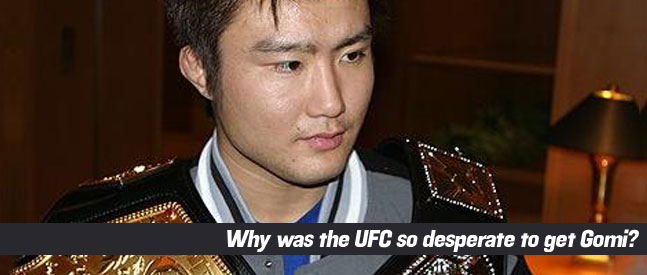 For the Zuffa brass, it’s a war that seems never ending. Years after the UFC dispatched its greatest rival, the Japanese PRIDE promotion, the company continues to wage a battle that reached an apex in 2005.
For the Zuffa brass, it’s a war that seems never ending. Years after the UFC dispatched its greatest rival, the Japanese PRIDE promotion, the company continues to wage a battle that reached an apex in 2005.
Despite the UFC’s tremendous financial and artistic success, for much of the last decade they were clearly an also-ran. The best fighters in the world gravitated to Japan where shows attracted tens of thousands of fans to live events and ten of millions of viewers on television. The UFC was home to stars like Chuck Liddell and Tito Ortiz, but the best of the best were all in PRIDE. Even as the talent gap closed, even as UFC matchmaker Joe Silva began constructing cards every as good a PRIDE’s famous spectacles, hardcore fans continued to consider PRIDE a step above their American rival.
For a man as competitive as UFC President Dana White, this was galling and completely unacceptable. He wanted more than to count piles and piles of cash. White wanted the best fighters on his cards. And no matter what he said publicly (he once famously suggested PRIDE champion Fedor Emelianenko couldn’t cut it in the Octagon) White knew (and still knows) his guys have to beat the best to be considered the best.
When PRIDE fighters come into the Octagon they face more than a hostile opponent-they are doing battle with the entire Zuffa empire. UFC executives still smart over the perceived disrespect that is now three years old. When Lyoto Machida fought PRIDE star Sokoudjou at UFC 79, announcer Joe Rogan was talking up Sokoudjou’s exploits in Tokyo. Silva then handed Rogan a note that encapsulated the UFC’s complicated feelings about their Japanese imports. “This,” the note read, “ain’t Japan.”
Years after PRIDE closed shop, victim of a Yakuza scandal that made the company untouchable for television executives, the UFC is still out to prove their guys are superior. Dana White and the Fertittas were openly celebrating when Forrest Griffin upset Mauricio “Shogun” Rua and they’ve seen UFC stars beat Wanderlei Silva, Quinton Jackson, and Antonio Rodrigo Nogueira as well. With Fedor Emelianenko signed to a Strikeforce contract, that leaves PRIDE fighters to vanquish few and far between. Enter Takanori Gomi.
Gomi was one of the last remaining Japanese superstars, a name synonymous with PRIDE and their Bushido series. Despite a record built mainly on tomato cans and hand- selected opponents either past their prime or too small to be competitive, Gomi is considered by many fans to be one of the very best in the world. He was carefully promoted by PRIDE, and despite Bushido being a box office bust, Gomi was considered a fighter with potential to cross over to the mainstream.
Zuffa is not a company filled with dummies. Unlike Vince McMahon’s World Wrestling Entertainment, they wouldn’t downplay Gomi because he comes from a competitor. Instead, they will build him up, making him a star if they can, expecting all the while he will lose and lose badly to their group of talented 155 pounders. Gomi is a highly skilled fighter, but one with plenty of weaknesses. His wrestling is passable, but not at the level of Gray Maynard and others in the division. His grappling once the fight hits the mat doesn’t compare to the UFC’s best. This was painfully exposed by Marcus Aurelio and his poor cardio was on display for the world in a loss to Nick Diaz (later declared a no contest). Since PRIDE’s demise, Gomi has struggled to maintain the discipline needed to train like a champion.
Zuffa knows all this. They are waiting for him to fail; a Gomi loss is another battle won in a war that has technically been over for three years.
Comments
The Forever War: How The UFC’s Obsession With PRIDE Led To Gomi’s Octagon Debut